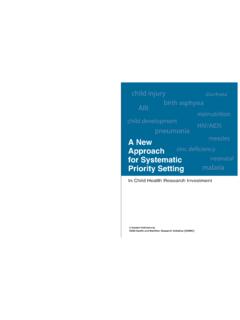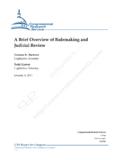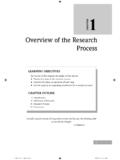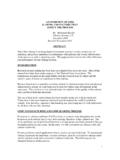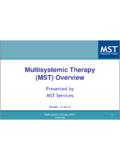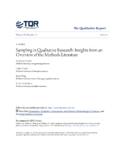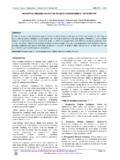Transcription of Health Research in Ethiopia - a country overview
1 Health Research in Ethiopia - a country overview 21. Background Ethiopia is one of the 15 African countries selected for the Africa Consultative process in preparation for the International Conference on Health Research for Development. This report refelcts a culmination of that process to which seven key national Research and teaching institutions have contributed under the guidance of the Ethiopian Science and Technology Commission (ESTC) led by the National Focal Point for the exercise.
2 2. National Characteristics Covering an area of approximately million square kilometres (444,000 square miles), Ethiopia is bordered by the Sudan on the west, Somalia and Djibouti on the east, Eritrea on the north and Kenya on the south. The diverse topography of the country generally features rugged mountains, flat top plateaux, deep river canyons, rolling plains and low lands. The central highlands generally enjoy a temperate and pleasant climate, while the lowlands have typically sub-tropical and tropical climates.
3 Currently with a population of more than 61 million, Ethiopia represents a melting pot of ancient Middle Eastern and African cultures, evident in the religious, ethnic language composition of its Semitic, Cushitic, Omotic and Nilotic peoples. The Ethiopian people comprise about 78 nationalities of which Amhara and Oromo constitute the majority, with about 60% of the total population. Ethiopia belongs to the group of least developed countries. Approximately 85% of the population live in rural areas.
4 The annual population growth rate is about 3%. The age group between 14 and 60 makes up about 50% of the population. Life expectancy at birth is estimated at 53 years, due to a very high premature mortality. Despite this, the population is expected to double in the next two decades, creating considerable pressure on social services, including Health . Mortality rates among children under five and infants are among the highest in the world. Similarly, maternal mortality is estimated to be 500-700/10 raised to 5 live births.
5 3 3. Research Development in Ethiopia Pre-Italian invasion Health Research development The antiquity of Ethiopian traditional medicine could not be established with any certainty due to the lack of adequate historical sources. The early report of Ethiopian traditional medicine was that of Francisco Alvarese in the early 16th century. The earliest known medicinal texts are the Geez Meshafa Faws of mid-17th century and Mashafa Medhanit of the early 18th century. These medical texts contain several references to plants, animal products and minerals, as well as magic and superstition.
6 The introduction of modern Health care services in Ethiopia can be traced back to the reign of Emperor Libne Dingel (1508-1540), when the Portuguese mission to his court brought in a physician named Bermudes. Over four centuries ago, modern Health care was brought to Ethiopia from many different countries by other European travellers, missionaries and members of the diplomatic community. In the reign of Emperor Menilik II (1889-1913), a modern Health care system was organized in the country .
7 During and after Italian invasion Health Research development During the Italian invasion and immediately after it, Italian physicians carried out most of the Health care and Health Research . Most of their work concentrated on infectious and parasitic diseases. The researchers were mainly located in what was formerly northern Ethiopia (Eritrea). The expansion of Health facilities continued through the era of Emperor Haile Selassie and during the subsequent governments that took charge of the country .
8 The opening of the following institutions accelerated Research activity in the country : - Pasteur Institute of Ethiopia (Now ENHR) 1951 - Ethiopian Nutrition Institute (ENI now ENHR) 1950 - Armor Hanson Research Institute (AHRI) 1969 - Faculty of Medicine-Addis Ababa University (FM-AAU) 1964 - Gonad College of Medical Science (GCMS) 1954 - Jim Institute of Health Science (JIHS) 1983 4- Institute of Path-Biology (IPB) 1966 - Ethiopia Science and Technology Commission (ESTC) 1975 With the increasing number of training and Research institutes, the effort in Health Research increased, both in volume and in the variety of fields.
9 Available records indicate that no less than 5,000 Health and Health related publications and documents are issued in Ethiopia . Despite the above developments, shortage of highly qualified researchers and the absence of a strong and functional Health Research system are the major problems that require immediate attention. 4 Health Research and the Ethiopian Science and Technology Commission (ESTC): Health Department As indicated above, the Ethiopian Science and Technology Commission was established by decree in 1975.
10 Initially Health Research activities were supported and encouraged mainly by the use of external funds. However, as of 1993, the present Government issued a policy and strategy allocating up to of GDP. Accordingly, activities got underway and there are well over 200 locally supported Health Research projects in progress. Efforts are under way to address the above-mentioned problems. A policy and strategy for Health science and technology is being formulated. The policy objectives are to utilize Health S&T to help to improve the Health status of the population at large and under-served Ethiopians in particular, in order to enhance productivity and raise the quality of life; to guide, coordinate, support and promote Health S&T in order to build up and strengthen sustainable capacity in Health S&T in the country .

